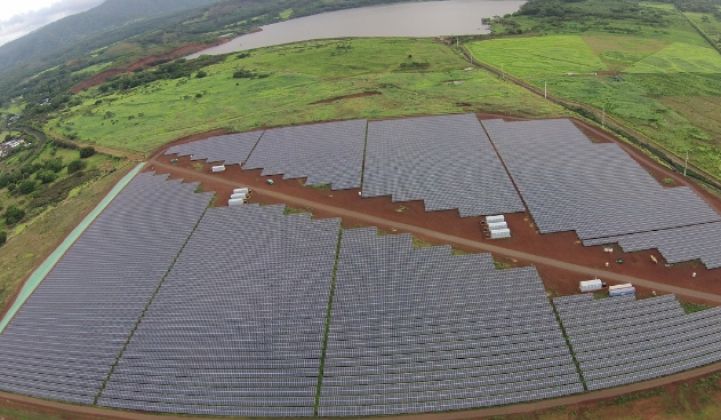Solar power, even after the sun goes down? A new utility-scale solar project with battery storage will supply power to the island of Kauai, Hawaii in the evening hours of 5-10 p.m., helping to meet peak demand after sunset while reducing greenhouse gas emissions.
In 2016, SolarCity will construct a 17-megawatt photovoltaic solar array on 50 acres adjacent to an existing power plant owned by Kauai Island Utility Cooperative (KIUC). The installation will include a 52-megawatt-hour battery system. SolarCity will sell power from the project to KIUC under a 20-year power-purchase agreement.
“The most interesting thing about this project is that it’s firm solar power,” said Peter Rive, founder and CTO of SolarCity. “That’s a new and important class of utility-scale solar power system. The batteries will store all the energy produced by the solar array, and then dispatch it to the grid as needed.”
Under the agreement, KIUC will purchase power for 14.5 cents per kilowatt-hour -- considerably less than the utility currently pays for comparable diesel generator capacity. Furthermore, KIUC noted that this is “only slightly more than the cost of energy from KIUC’s two existing 12-megawatt solar arrays, whose output is available only during the day.”
Rive explained that KIUC will commit to drawing a certain amount of power from the battery, but that the utility will be billed only at the time it draws power.
“KIUC has been investigating energy storage options for more than two years, and price has always been the biggest challenge,” said David Bissell, president and CEO of KIUC. “This is a breakthrough project on technology and on price that enables us to move solar energy to the peak demand hours in the evening and reduce the amount of fossil fuel we’re using.”
The cost of battery storage has been dropping steadily in recent years, but it’s still fairly pricey. Hawaii has the nation’s highest power costs, so that improves the economics of large-scale battery storage there. But Rive notes, “SolarCity is not subsidizing the cost of this system. We’re making good enough money on this, and it’s also a good deal for KIUC.”
The clock is ticking, however. At the end of 2016, the federal solar Investment Tax Credit (ITC) drops from 30 percent to 10 percent. To qualify for the ITC, construction work must begin by April 2016 and the project must be producing power by December 31, 2016. KIUC has requested accelerated approval from the Hawaii Public Utilities Commission, and SolarCity confirmed that the battery storage system and solar array will be eligible for the credit.
Siting the solar project next to an existing KIUC power plant will greatly reduce the cost and complexity of grid interconnection, Rive said. “So much of the fixed gear is already there, and we won’t have to build long transmission lines.”
Serving a large amount of load from batteries is expected to provide power quality advantages, particularly frequency support. This can be a considerable benefit for a co-op that serves a widely dispersed and largely rural customer base.
The manufacturer of the battery has not yet been selected, but Rive says Tesla is a leading contender. “We think their technology is ahead of the pack for this kind of application.”
This is the second utility-scale solar project that SolarCity has built for KIUC. A year ago, the utility commenced operation of a 12-megawatt solar farm on Kauai, which supplies about 5 percent of the island’s annual electricity needs.
Utility-scale solar farms with battery storage might help Kauai avoid some of the problems that the neighboring island of Oahu has experienced due to the surge in rooftop solar deployment. Recently, the stability of Oahu’s distribution grid has been challenged by solar, as 13 percent of residents there have PV systems installed on their homes.



